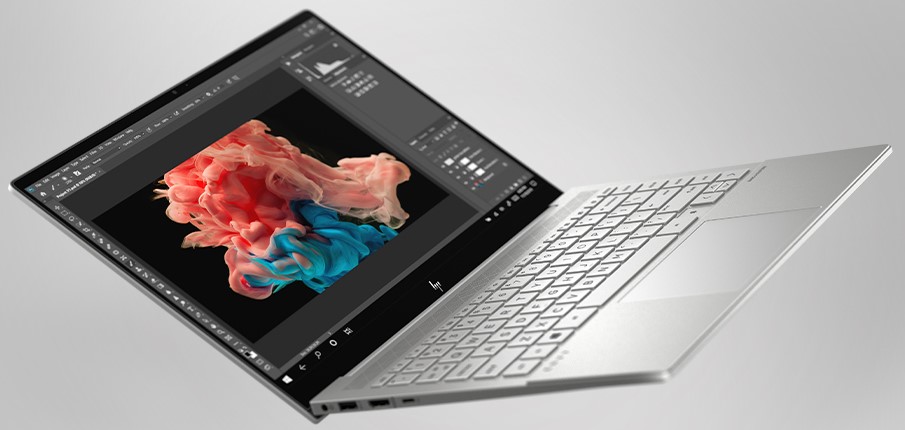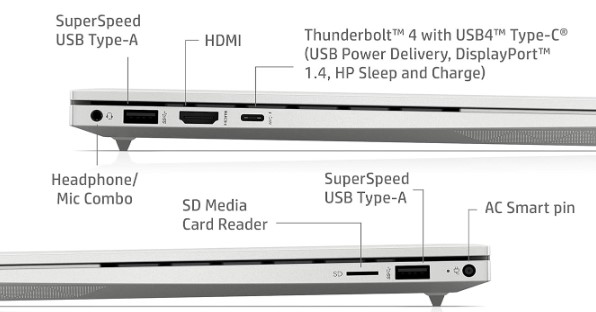In this article, I give you my HP Envy 14-inch (2021) review with specs included. You might feel sometimes like laptops and technology are stagnating, not moving along, but then you look at something like this and you realize that things are actually looking up.
This is a 14-inch ultrabook with aluminum chassis. That’s all nice that’s all good that’s an Envy but this brings some of the goodness of what the Envy 15 was down to a pretty compact and portable size.
We have Intel 11th gen ultrabook CPUs inside and we have Nvidia GTX 1650 Ti Max-Q graphics inside. So, it’s quite powerful for something this compact. And, the battery life isn’t bad either.

Honestly, it’s hard to fault the Envy line and there’s a reason why it’s popular. It has that premium feel without the insane price tag for the laptop. It has a definite chill, low-key design aluminum chassis that I like. No dated funny angles and bling that might not look good a couple of years from now, it’s all good.
The finish is all nice and flush on it. There’s no creaking, it’s pretty solid, the stuff that you would expect for around a thousand dollars and up. In fact, my configuration with the Nvidia dedicated graphics, a Core i5 (which is about 10 slower than the Core i7), 16 GB of RAM, and 256 GB SSD is about $1250 MSRP.

Now, if you’re building your own on HP’s website and you want that Core i7 it’s about $50 more. In fact, on HP’s website, $50 also takes you from 8 to 16 GB of RAM but my model is a 16 GB unit already.
The only thing that I would complain about a bit is the display. This is a traditional clamshell laptop, it’s not a convertible like the HP Spectre X360. The display doesn’t go that far back.
Some of us who want to tilt the display a little further back might find this kind of a dealbreaker. Also, I think that the whole lid design where the lid lifts up the bottom a little bit is not that great practically. Anyway, small things to complain about there.

The keyboard and trackpad on this are both pleasant. The drawback with HP and their silvery laptops is that it’s a little hard to see the key masking. Once you put the backlighting on, which is pretty bright and white, it actually becomes easier but in that kind of middling light, it’s a little indistinct looking.
The tactile feel of the keys is very nice on this. There’s some spring and return and all that sort of thing. It’s not ultra-shallow or anything like that. I like it pretty well.
And, I also appreciate the fact that the power button may be embedded in the keyboard but it is not the uppermost right key where the delete key usually is. So none of that ‘whoopsie oh I want to hit the Dell key and I turned off the laptop instead’.

The trackpad is Microsoft Precision HP, as usual, a large trackpad. It’s a little on the slipping side but I think most people will find it just fine.
By the way, the very lowest-end model that’s on HP’s website (at the time of writing this) is like 1069 US dollars, that’s the only one that does not have the dedicated graphics inside. It just says Intel Iris Xe graphics, so keep that in mind if you see it at a super cheap price make sure you get the one with dedicated graphics instead.
By the way, you still get the same dual fan design cooling even if you don’t have the dedicated graphics. So that one must run super chill.

You do have your choice of an Intel Core i5 or a Core i7 CPU (Intel 11th gen Tiger Lake), and those are 15-watt ultrabook CPUs inside. Also, Intel Iris Xe graphics that is switchable via Optimus with the Nvidia dedicated graphics onboard.
So, it is a fairly powerful machine. And, given the fact that it does have dual fans and it’s a thin chassis, but not crazy thin, the cooling on this is pretty effective. So that’s the other thing that’s nice to see.
Often when we shrink these things down it gets to be tougher to get cooling right. But, as we’ve seen with the Razer Blade Stealth and the very few others that have this level of GPU inside in a smallish package, it is doable nowadays.

RAM is soldered onboard, as it is with most ultrabooks. You can get it with 8 or 16 GB of DDR4 RAM and it has one M.2 SSD slot. So, that is upgradeable and you can get anywhere from 256 GB (which my $1250 model has), all the way up to 2 terabytes if you’re going to order on HP’s website.
Intel Wi-Fi 6 is a standard AX201 card. And, we have a fingerprint scanner that’s pretty obviously embedded in the keyboard, it has its own dedicated key. There is no Windows Hello IR camera.
HP says the display on this is calibrated at the factory and it has a delta E of two or less. That is pretty good and they didn’t go for less because it’s pretty decent calibration.
It’s not a super wonderful spot-on calibration but it’s good enough probably for most people. If you’re really serious about your graphics work then you probably have a colorimeter anyway or you know to borrow one from work.

My one complaint about this display is the same as with almost all of HP’s higher-end laptops. The glossy display is too glassy-looking. There are a lot of reflectances and the default wallpaper that is shipped with, which already has a kind of dark and dithered look, didn’t help in any way.
So, if you boot it up and you see a sad-looking wallpaper there, change it before you make your judgment on the display. But glare is a reality with this one.
HP Envy 14-inch (2021) is available with full HD plus 1920×1200 and you can get 400 nits either way but touch or non-touch are the two options. No pen support with this one. I have the touchscreen option on mine.

The rest of the metrics you can see below. They’re pretty good. The contrast is pretty decent on this. Color gamut is pretty nice in this price range as well. So, it’s a pleasant display, and if you’re looking to get into some photo or video editing and all that sort of thing the display is up to the job certainly. And, it looks very nice if you’re consuming media on it.
For a relatively compact laptop, the port situation is pretty good. Since this is Intel 11th gen we have one Thunderbolt 4 port which is also USB-C. So that handles display out, Thunderbolt docks, as well as USB-C dock. So, that’s good to see.
We have two USB-A 3.1 ports. Those are five gigabits per second. HDMI 2.0, a headphone jack, and a MicroSD card slot. So no dongle life here and in that regard it’s a little more appealing than the Spectre X360 maybe.

And though it’s not per se a gaming laptop, most obviously, I know some of you do like to game a little bit and that GTX 1650 Ti Max-Q will get you there with older games or less demanding games or with your settings put to ‘Low’.
I mean, I wouldn’t pick this one for Cyberpunk 2077 but if you’re looking at playing something like Fortnite, absolutely not a problem. Actually, even Overwatch would work just fine.
It’s a 60-hertz refresh display so you’re not looking to push more frames than that unless you’re using a fancy external monitor anyway. So, in short, you can play a few games too.
HP Envy 14-inch (2021) is really designed for creators who are doing a bit more graphical work. Maybe you’re getting into rendering, Blender, that sort of stuff.
Sometimes dedicated graphics are not so good when it comes to battery life. Well, we have Nvidia Optimus Switchable Graphics here and these days Optimus does a pretty good job of turning off the dedicated GPU when you don’t really need it.
63-watt hour battery and 135-watt charger with a proprietary barrel pin-style connector, HP’s usual sort of bigger charger here, because it’s beyond the USB-C power delivery limit of 100 watts required.
Battery life on this is actually pretty good and so are charging times. It can charge fully in less than two hours from empty to full. But, in mixed productivity use (a little streaming video, a little bit of Photoshop, usual Office work, that sort of thing, with the display set to 200 nits) I was getting eight to nine hours.
Now, if you’re gonna do Premiere or anything that’s going to involve the dedicated GPU, you do expect the battery runtimes to go down a bit from that. But, yeah it’s not bad at all.
As per usual with HP, we have Bang & Olufsen branded stereo speakers and they’re pretty decent. The volume is pretty good on this. Don’t expect an amazing base, or something like that, but not too bad at all.
So, that’s the HP Envy 14 for 2021, the Spectre X360 might envy it for its power. Granted, it’s not a convertible, it’s not as thin and light as a Spectre X360, and there’s no OLED 4K option, but then this one’s a lot less expensive.
And again, in this price range, this is going to be one of the ones to beat for those who are looking for some graphics power in a nice, classy, well-built machine.
HP Envy 14-inch (2021)
-
Performance - 94%94%
-
Price - 93%93%
-
Value - 94%94%

